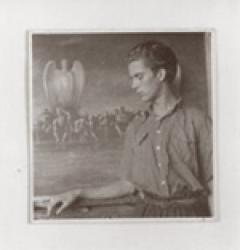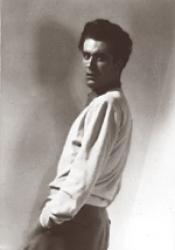The End of the War
 Michael Ende and ‘Die Dürstenden’ (The Parched) by Edgar Ende.
Michael Ende and ‘Die Dürstenden’ (The Parched) by Edgar Ende. Michael Ende in 1950
Michael Ende in 1950During the final year of war, male evacuees of fourteen or fifteen years of age were drafted into the army and the Waffen-SS and sent to face the American tanks. Three of Michael Ende’s classmates were killed on their first day of action. Ende also received call-up papers, but tore up the letter and made his way home to his mother in Munich. By then the German army was already in retreat. Corpses of deserters hung by the wayside, strung up in the trees by the SS or the military police. Michael Ende came into contact with a Bavarian resistance movement founded to sabotage the German war effort and bring about its capitulation. Ende was used as a courier, and the operation succeeded in undermining the SS’s declared intention to defend Munich until the ‘bitter end’.
Michael Ende’s attitude towards life was profoundly influenced by his experience of war. He was paralysed by a kind of defeatism and always expected the worst. It seemed to him that the world was falling apart, and he saw disaster as part of everyday life. In fact, it surprised him when catastrophes didn’t materialize.
In 1945 the Ende family left Solln and moved to no. 135a Leopoldstraβe in Schwabing. Edgar Ende shared a studio there with a painter of the Munich school, Richard Ferdinand Schmitz - one of the few surviving members of the circle around Stefan George, Friedrich Gundolf and Karl Wolfskehl.
In 1946 Michael Ende’s grammar school re-opened, and he attended classes for a year, after which the financial generosity of family friends allowed him to complete his high-school education at a Waldorf school in Stuttgart. This seemingly charitable gesture was motivated by more self-interested calculations: Ende had fallen in love with a girl three years his senior, and her parents funded his two-year stay in Stuttgart to keep the pair apart.